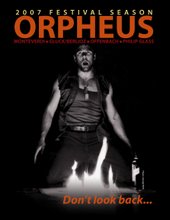One more Orpheus
Although all the mainstage productions have opened, Glimmerglass still has one more new work to present--a concert version of Haydn's L'Anima del Filosofo. The opera was never performed during Haydn's life and is still rarely presented.


Because the concert must fit into the busy production schedule, it rehearsed on the Offenbach set, but will be performed on the Monteverdi set and the Gluck set.
This is the first year that Glimmerglass has presented a concert in addition to the four mainstage productions. The work made its Glimmerglass premiere on Sunday. There will be one more performance on August 19 that is already sold out. Plans are already in the works for another Shakespeare-themed concert next season. Repertoire will include music from Mendelssohn's A Midsummer Night's Dream.





